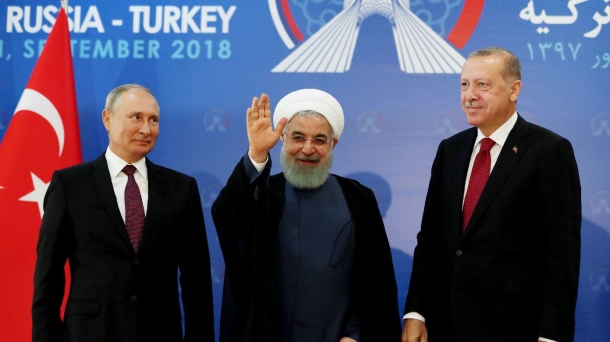Iran's Role in International Politics
Navigating Regional Power, Global Tensions, and Ideological Ambitions
Regional Influence and the Axis of Resistance
Iran exerts significant influence in the Middle East through its "Axis of Resistance," a network of allied non-state actors and states, countering adversaries like Israel and Saudi Arabia.
- Support for Proxies: Iran backs Hezbollah in Lebanon, Hamas in Palestine, Shia militias in Iraq, and the Houthis in Yemen, extending its influence in regional conflicts without direct engagement [1], [2].
- Strategic Rivalries: Iran competes with Saudi Arabia for regional dominance, fueling proxy wars in Yemen and Syria. The 2023 China-brokered détente with Saudi Arabia signals pragmatic diplomacy [3].
- Syria's Fall: The 2024 collapse of the Assad regime, a key ally, weakened Iran's regional leverage, particularly in the Levant [4].
Nuclear Program and Global Tensions
Iran's nuclear ambitions remain a focal point of international contention, balancing deterrence with diplomatic isolation.
- JCPOA and Sanctions: The 2015 nuclear deal (JCPOA) limited Iran's nuclear activities but collapsed after the U.S. withdrawal in 2018. Iran's subsequent enrichment to 60% uranium heightened tensions [4], [1].
- 2025 Developments: In June 2025, Israeli strikes on nuclear facilities like Natanz, coupled with Iran's suspension of IAEA cooperation, raised fears of escalation and potential "snapback" sanctions [5], [6].
- Strategic Leverage: The nuclear program serves as both a bargaining chip and a symbol of defiance, though it deepens economic isolation via sanctions [7].
Anti-Western Stance and "Look East" Strategy
Iran's rejection of Western hegemony drives its alignment with non-Western powers.
- Russia and China Ties: Iran's "Look East" strategy includes military cooperation with Russia (e.g., drone supplies) and economic ties with China (e.g., oil exports). Its 2024 BRICS membership bolsters this pivot [8], [9].
- Anti-U.S. and Anti-Israel Rhetoric: Iran's opposition to U.S. and Israeli policies, including support for Palestinian groups, reinforces its revolutionary identity but strains relations with Western-aligned states [4], [10].
- Diplomatic Outreach: Efforts to engage with BRICS and regional neighbors like Qatar and Oman reflect Iran's pursuit of strategic autonomy [9].
Domestic Politics and Foreign Policy Centralization
Iran's foreign policy is tightly controlled by unelected institutions, limiting reformist influence.
- IRGC Dominance: The Islamic Revolutionary Guard Corps (IRGC) and Supreme Leader Ayatollah Ali Khamenei centralize decision-making, sidelining the Ministry of Foreign Affairs [11], [12].
- Hardline Shift: Increased militarization and authoritarianism, especially post-2022 protests, constrain President Pezeshkian's reformist agenda [11], [13].
- Domestic Pressures: Economic crises and protests, like the 2022 "Woman, Life, Freedom" movement, push Iran toward self-reliance and non-Western alliances [13], [14].
Human Rights and International Criticism
Iran's human rights record draws global scrutiny, complicating its diplomatic relations.
- Repression and Executions: Over 700 executions in 2023 and crackdowns on dissent, including the 2022 protests, have led to accusations of systemic abuses [15], [16].
- Transnational Repression: Detentions of dual nationals and alleged hostage-taking tactics strain ties with Western nations [15].
- Defiant Stance: Iran rejects criticism, claiming its human rights record compares favorably to others, further isolating it diplomatically [17].
Economic and Geopolitical Ambitions
Iran leverages its strategic location and resources to pursue regional and global influence.
- Economic Challenges: Sanctions and low oil prices (e.g., Brent crude below $80/barrel in 2014) strain Iran's economy, pushing reliance on China and illicit trade [17], [18].
- Regional Hub Aspirations: Iran's location between the Caspian Sea and Persian Gulf supports initiatives like the North-South Transport Corridor, cutting trade costs by 30% [4], [19].
- Great Power Vision: Iran seeks great power status, drawing on historical Persian legacy and BRICS membership to counter Western dominance [7], [9].
Recent Developments (2025)
Key events in 2025 highlight Iran's evolving role amid challenges and opportunities.
- Iran-Israel Conflict: Israeli strikes on nuclear and military sites in June 2025, followed by Iran's missile retaliation, exposed vulnerabilities but showcased resilience. A ceasefire was achieved through diplomacy [5], [12].
- Diplomatic Shifts: Posts on X suggest Iran may explore opportunity-driven policies, as proposed by former Foreign Minister Javad Zarif [20].
- Leadership Transition: With Supreme Leader Khamenei's health in question, the IRGC's growing influence may entrench hardline policies, though reformist pressures persist [13], [12].
Conclusion
Iran's role in international politics blends ideological resistance, regional influence through proxies, and strategic alignment with non-Western powers like Russia and China. Its nuclear program and human rights record fuel global tensions, while economic challenges and domestic unrest limit flexibility. Recent events, like the 2025 Iran-Israel conflict and BRICS engagement, underscore Iran's resilience and vulnerabilities. Future influence depends on balancing revolutionary ideals with pragmatic diplomacy and navigating the looming leadership transition [3], [9], [13].
